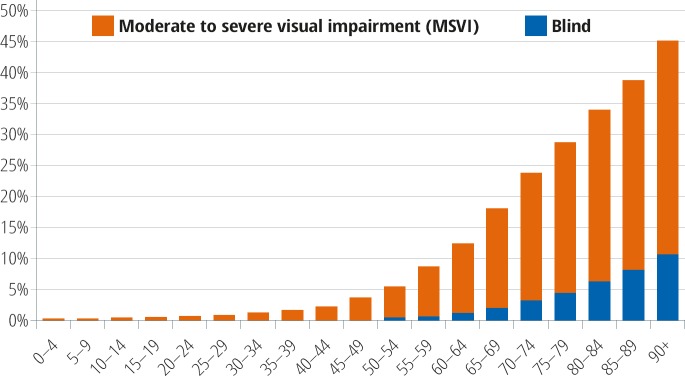Vision Loss and V1
85
Learning Objectives
Know the definition of low vision and legal blindness.
Know the prevalence of low vision.
Being able to explain why we are still expecting more low vision people in our society given that we have better and more treatments for many eye diseases.
Low vision is defined as the visual acuity in one’s best eye being worse than 20/60 even with correction. Low vision occurs in 2% of the worldwide population (around 124 million people).

For one to be constituted as legally blind, the visual acuity of their best eye must be worse than 20/200 (or only 20 deg. visual field). 0.6% of the worldwide population is blind.
With the youngest of the baby boomers hitting 65 by 2029, the number of people with visual impairment or blindness in the United States is expected to double to more than 8 million by 2050, according to projections based on the most recent census data and from studies funded by the National Eye Institute (part of the National Institutes of Health). The data tells us that we should prepare for the surge in visual impairment by implementing further nationwide screening in order to identify people with correctable vision problems and early signs of eye disease. Early detection and intervention could be one of the best options in our attempt to avoid a significant proportion of avoidable vision loss (Fig.9.1.1). Once low vision or blindness occur, they are usually permanent, making early detection and intervention one of the top priorities in our attempt to avoid a significant proportion of avoidable vision loss.

Cheryl Olman PSY 3031 Detailed Outline
Provided by: University of Minnesota
Download for free at http://vision.psych.umn.edu/users/caolman/courses/PSY3031/
License of original source: CC Attribution 4.0
Adapted by: Mckenzie RobertsCONTENT SHARED PREVIOUSLY
National Eye Institute, “Visual impairment, blindness cases in U.S. expected to double by 2050”
URL: https://www.nei.nih.gov/about/news-and-events/news/visual-impairment-blindness-cases-us-expected-double-2050
License: PDM
Adapted by: Mckenzie Roberts
Reference
Varma, R et al, “Visual impairment and blindness in adults in the United States: Demographic and Geographic Variations from 2015 to 2050,” JAMA Ophthalmology, DOI:10.1001/jamaophthalmol.2016.1284 Pubmed

